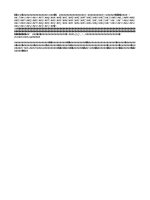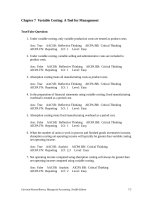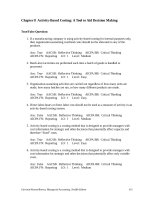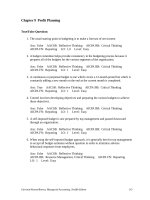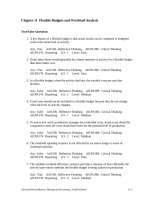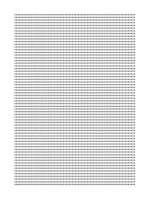TEST BANK MANAGERIAL ACCOUNTING 4TH EDITION BRAUN chapter 2
Bạn đang xem bản rút gọn của tài liệu. Xem và tải ngay bản đầy đủ của tài liệu tại đây (1.1 MB, 123 trang )
Managerial Accounting, 4e (Braun/Tietz)
Chapter 2 Building Blocks of Managerial Accounting
1) Service companies must carry a large amount of inventory to meet consumer demand.
Answer: FALSE
Diff: 1
LO: 2-1
EOC: S2-2
AACSB: Reflective thinking
Learning Outcome: Define and use cost-volume-profit analysis to analyze the effects of changes.
2) Manufacturing companies usually have three types of inventory.
Answer: TRUE
Diff: 1
LO: 2-1
EOC: S2-2
AACSB: Reflective thinking
Learning Outcome: Define and use cost-volume-profit analysis to analyze the effects of changes.
3) Retailers sell their products to consumers.
Answer: TRUE
Diff: 1
LO: 2-1
EOC: S2-2
AACSB: Reflective thinking
Learning Outcome: Define and use cost-volume-profit analysis to analyze the effects of changes.
4) Merchandising companies include both wholesalers and retailers.
Answer: TRUE
Diff: 1
LO: 2-1
EOC: S2-2
AACSB: Reflective thinking
Learning Outcome: Define and use cost-volume-profit analysis to analyze the effects of changes.
5) All companies have the same types of inventories.
Answer: FALSE
Diff: 1
LO: 2-1
EOC: S2-2
AACSB: Reflective thinking
Learning Outcome: Define and use cost-volume-profit analysis to analyze the effects of changes.
6) Only manufacturing companies have finished goods inventory.
Answer: TRUE
Diff: 2
LO: 2-1
EOC: S2-2
AACSB: Reflective thinking
Learning Outcome: Define and use cost-volume-profit analysis to analyze the effects of changes.
7) Which of the following are merchandising companies?
A) Manufacturers
B) Retailers
C) Wholesalers
D) Both retailers and wholesalers
Answer: D
Diff: 1
LO: 2-1
1
Copyright © 2015 Pearson Education, Inc.
EOC: S2-2
AACSB: Analytical thinking
Learning Outcome: Define and use cost-volume-profit analysis to analyze the effects of changes.
8) Which of the following types of companies has raw materials, work in process and finished
goods inventory?
A) Retailers
B) Manufacturers
C) Wholesalers
D) Service companies
Answer: B
Diff: 1
LO: 2-1
EOC: S2-2
AACSB: Reflective thinking
Learning Outcome: Define and use cost-volume-profit analysis to analyze the effects of changes.
9) Which type of company makes up the largest sector of the United States economy?
A) Manufacturers
B) Merchandising
C) Wholesalers
D) Service companies
Answer: D
Diff: 1
LO: 2-1
EOC: S2-2
AACSB: Reflective thinking
Learning Outcome: Define and use cost-volume-profit analysis to analyze the effects of changes.
10) The balance sheet of a service company has
A) raw materials inventory.
B) little or no inventory.
C) three categories of inventory.
D) two categories of inventory.
Answer: B
Diff: 1
LO: 2-1
EOC: S2-1
AACSB: Reflective thinking
Learning Outcome: Define and use cost-volume-profit analysis to analyze the effects of changes.
2
Copyright © 2015 Pearson Education, Inc.
11) Schlabig & Associates, a public accounting firm that provides business consulting to a
consumer, is what type of company?
A) Manufacturer
B) Retailer
C) Service
D) Wholesaler
Answer: C
Diff: 1
LO: 2-1
EOC: S2-2
AACSB: Reflective thinking
Learning Outcome: Define and use cost-volume-profit analysis to analyze the effects of changes.
12) Jiffy Lube, an automotive maintenance company, is primarily what type of company?
A) Manufacturer
B) Retailer
C) Wholesaler
D) Service
Answer: D
Diff: 1
LO: 2-1
EOC: S2-2
AACSB: Reflective thinking
Learning Outcome: Define and use cost-volume-profit analysis to analyze the effects of changes.
13) Among other products, Nabisco makes Oreo cookies. Which type of company is Nabisco?
A) Service
B) Manufacturer
C) Retailer
D) Wholesaler
Answer: B
Diff: 1
LO: 2-1
EOC: S2-2
AACSB: Reflective thinking
Learning Outcome: Define and use cost-volume-profit analysis to analyze the effects of changes.
14) Which type of company typically produces its own inventory?
A) Manufacturer
B) Service company
C) Retailer
D) Wholesaler
Answer: A
Diff: 1
LO: 2-1
EOC: S2-2
AACSB: Reflective thinking
Learning Outcome: Define and use cost-volume-profit analysis to analyze the effects of changes.
3
Copyright © 2015 Pearson Education, Inc.
15) What type of company resells tangible products it purchases ready-made from suppliers?
A) Merchandiser
B) Retailer
C) Wholesaler
D) All of the above
Answer: A
Diff: 1
LO: 2-1
EOC: S2-2
AACSB: Reflective thinking
Learning Outcome: Define and use cost-volume-profit analysis to analyze the effects of changes.
16) Before these materials are used to manufacture its cars, Toyota classifies steel, glass,
and plastic as
A) raw materials inventory.
B) finished goods inventory.
C) work in process inventory.
D) merchandise inventory.
Answer: A
Diff: 1
LO: 2-1
EOC: S2-2
AACSB: Reflective thinking
Learning Outcome: Define and use cost-volume-profit analysis to analyze the effects of changes.
17) Before these materials are used to manufacture cabinets, a woodworker classifies
lumber, paint, and glue as
A) finished goods inventory.
B) work in process inventory.
C) raw materials inventory.
D) merchandise inventory.
Answer: C
Diff: 1
LO: 2-1
EOC: S2-2
AACSB: Reflective thinking
Learning Outcome: Define and use cost-volume-profit analysis to analyze the effects of changes.
18) Macy's (the department store chain) classifies its clothing held for sale as
A) merchandise inventory.
B) raw materials inventory.
C) work in process inventory.
D) finished goods inventory.
Answer: A
Diff: 1
LO: 2-1
EOC: S2-2
AACSB: Reflective thinking
Learning Outcome: Define and use cost-volume-profit analysis to analyze the effects of changes.
4
Copyright © 2015 Pearson Education, Inc.
19) American Eagle Outfitters classifies the denim jeans on the shelves at its retail locations
as
A) finished goods inventory.
B) work in process inventory.
C) merchandise inventory.
D) raw materials inventory.
Answer: C
Diff: 1
LO: 2-1
EOC: S2-2
AACSB: Reflective thinking
Learning Outcome: Define and use cost-volume-profit analysis to analyze the effects of changes.
20) How would Chevrolet classify its partially completed vehicles?
A) Finished goods inventory
B) Raw materials inventory
C) Work in process inventory
D) Supplies inventory
Answer: C
Diff: 1
LO: 2-1
EOC: S2-2
AACSB: Reflective thinking
Learning Outcome: Define and use cost-volume-profit analysis to analyze the effects of changes.
21) In the United States, the fastest growing type of company is
A) merchandising.
B) service.
C) manufacturing.
D) none of the above.
Answer: B
Diff: 1
LO: 2-1
EOC: S2-2
AACSB: Reflective thinking
Learning Outcome: Define and use cost-volume-profit analysis to analyze the effects of changes.
22) Which of the following is a characteristic of a service company?
A) Service companies make a product.
B) Service companies have a single category of inventory.
C) Service companies generally have no tangible products to sell.
D) Service companies transform raw materials into finished goods.
Answer: C
Diff: 1
LO: 2-1
EOC: S2-2
AACSB: Reflective thinking
Learning Outcome: Define and use cost-volume-profit analysis to analyze the effects of changes.
5
Copyright © 2015 Pearson Education, Inc.
23) A snow removal business would be classified as a
A) manufacturing company.
B) merchandising company.
C) simple company.
D) service company.
Answer: D
Diff: 1
LO: 2-1
EOC: S2-2
AACSB: Reflective thinking
Learning Outcome: Define and use cost-volume-profit analysis to analyze the effects of changes.
24) An accounting firm would be classified as a
A) manufacturing company.
B) merchandising company.
C) simple company.
D) service company.
Answer: D
Diff: 1
LO: 2-1
EOC: S2-2
AACSB: Reflective thinking
Learning Outcome: Define and use cost-volume-profit analysis to analyze the effects of changes.
25) Toshiba Corporation makes computer chips. Toshiba Corporation would be classified as a
A) merchandising company.
B) manufacturing company.
C) service company.
D) simple company.
Answer: B
Diff: 1
LO: 2-1
EOC: S2-2
AACSB: Reflective thinking
Learning Outcome: Define and use cost-volume-profit analysis to analyze the effects of changes.
26) Which type of company has three categories of inventory?
A) A manufacturing company
B) A merchandising company
C) A service company
D) All of these companies
Answer: A
Diff: 1
LO: 2-1
EOC: S2-2
AACSB: Reflective thinking
Learning Outcome: Define and use cost-volume-profit analysis to analyze the effects of changes.
6
Copyright © 2015 Pearson Education, Inc.
27) In which of the following common types of business companies have costs of business
activities that include inventory-related freight in costs and the cost of import duties or
tariffs?
A) service company
B) manufacturing company
C) merchandising company
D) all of these companies
Answer: C
Diff: 1
LO: 2-1
EOC: S2-2
AACSB: Reflective thinking
Learning Outcome: Define and use cost-volume-profit analysis to analyze the effects of changes.
28) In a (an) ________ company, salaries and benefits make up over 70% of the total costs.
A) merchandising
B) service
C) manufacturing
D) All companies have a high percentage of labor costs.
Answer: B
Diff: 1
LO: 2-1
EOC: S2-1
AACSB: Reflective thinking
Learning Outcome: Define and use cost-volume-profit analysis to analyze the effects of changes.
29) A ________ company's balance sheet reports just one inventory called "Inventory."
A) service
B) merchandising
C) manufacturing
D) All of these types of companies
Answer: B
Diff: 1
LO: 2-1
EOC: S2-1
AACSB: Reflective thinking
Learning Outcome: Define and use cost-volume-profit analysis to analyze the effects of changes.
30) All of the following items would be found in raw materials inventory for a furniture
manufacturer except
A) wood.
B) fabric.
C) steel framing.
D) assembly worker wages.
Answer: D
Diff: 1
LO: 2-1
EOC: S2-2
AACSB: Reflective thinking
Learning Outcome: Define and use cost-volume-profit analysis to analyze the effects of changes.
31) Which of the following items could be found in work in process inventory at a candy bar
manufacturer?
A) Candy bars made but not coated in chocolate
B) Cocoa products to make candy bars
C) Sugar products to make candy bars
D) Candy bars completed but not yet sold
Answer: A
7
Copyright © 2015 Pearson Education, Inc.
Diff: 1
LO: 2-1
EOC: S2-2
AACSB: Analytical thinking
Learning Outcome: Define and use cost-volume-profit analysis to analyze the effects of changes.
32) Enter the letter of the type of each company category on the line in front of each
statement. Letters may be used more than once or not at all.
A. service company
B. merchandising company
C. manufacturing company
________ generally has no or minimal inventory
________ has three types of inventory
________ inventory consists of freight-in and the cost of the product
________ salaries and benefits make up 70% of costs
________ Wal-Mart is an example of this company category
Answer: A, C, B, A, B
Diff: 1
LO: 2-1
EOC: S2-1
AACSB: Reflective thinking
Learning Outcome: Define and use cost-volume-profit analysis to analyze the effects of changes.
8
Copyright © 2015 Pearson Education, Inc.
33) On the line in front of each statement, enter the letter corresponding to the term that
best fits that statement. You may use a letter more than once and some letters may not be
used at all.
A.
B.
C.
D.
Raw materials inventory E.
Service companies
F.
Merchandise inventory G.
Finished goods inventory
Work in process inventory
Manufacturing companies
Merchandising companies
________ has a single category of inventory
________ resells products previously purchased ready-made from a supplier
________ inventory is not sold for a profit
________ produces its own inventory
________ transforms raw materials into a new finished product
________ completed goods that have not been sold
________ partially completed items of manufacturers
________ steel, glass, tires, upholstery, and fabric that Toyota uses to manufacture products
Answer: G, G has a single category of inventory
G
resells products previously purchased ready-made from a supplier
B
inventory is not sold for a profit
F
produces its own inventory
F
transforms raw materials into a new finished product
D, F completed goods that have not been sold
E, F partially completed items of manufacturers
A
steel, glass, tires, upholstery, and fabric that Toyota uses to manufacture products
Diff: 2
LO: 2-1
EOC: S2-2
AACSB: Reflective thinking
Learning Outcome: Define and use cost-volume-profit analysis to analyze the effects of changes.
34) Describe service, merchandising, and manufacturing companies.
Answer: Service companies sell intangible services such as insurance, consulting, banking,
and healthcare. Salaries and wages include 70% of their costs. They usually do not have
inventory or cost of goods sold accounts, although some service companies will have a small
amount of supplies inventory which is used for their own use and not for sale to customers.
Merchandising companies resell tangible products they purchase from suppliers. Retailers
and wholesalers include both types of merchandising companies. Merchandisers have
inventory. Manufacturing companies use labor, plant and equipment to convert raw
materials into finished products that they sell to other companies. The three types of
inventory include: raw materials inventory, work in process inventory, and finished goods
inventory.
Diff: 2
LO: 2-1
EOC: S2-1; S2-2
AACSB: Reflective thinking
Learning Outcome: Define and use cost-volume-profit analysis to analyze the effects of changes.
9
Copyright © 2015 Pearson Education, Inc.
35) Explain the difference between raw materials inventory, work in process inventory, and
finished goods inventory.
Answer: Raw materials inventory includes all materials used to make a product including
materials that become a part of the product as well as other physical materials used in a
plant such as machine lubricants and janitorial supplies. Work in process inventory includes
goods that are in the middle of the manufacturing process; however, the product is not
complete. Finished goods inventory includes completed goods that have not yet been sold to
a consumer or group in the marketplace.
Diff: 1
LO: 2-1
EOC: S2-2
AACSB: Reflective thinking
Learning Outcome: Define and use cost-volume-profit analysis to analyze the effects of changes.
36) Describe a company that has some elements of all three types of companies. It is part
service company, part manufacturer, and part merchandiser.
Answer: Many restaurants fall into this category because most restaurants are a service
company since they serve hungry customers. A restaurant is also considered a manufacturer
if the restaurant converts raw ingredients into finished meals. A restaurant is also
considered a merchandise company if the restaurant sells ready-to-serve bottles of beer and
wine to consumers and groups in the marketplace. Outback Steakhouse is an example of a
restaurant that is categorized as a service company, a merchandise company, and a
manufacturing company.
Diff: 2
LO: 2-1
EOC: S2-2
AACSB: Reflective thinking
Learning Outcome: Define and use cost-volume-profit analysis to analyze the effects of changes.
37) Explain the type of inventory that is characteristic at a service company.
Answer: Service firms do not have inventory costs because services cannot be produced
today and stored to sell to a consumer later. They do not generally have inventory; however,
some service providers do carry a minimal amount of supply inventory used for internal
operations, and it is not sold to generate a profit.
Diff: 2
LO: 2-1
EOC: S2-2
AACSB: Reflective thinking
Learning Outcome: Define and use cost-volume-profit analysis to analyze the effects of changes.
38) Controlling costs across the whole value chain often requires a trade-off between the
individual elements of the value chain.
Answer: TRUE
Diff: 1
LO: 2-2
EOC: S2-3
AACSB: Reflective thinking
Learning Outcome: Define and use cost-volume-profit analysis to analyze the effects of changes.
10
Copyright © 2015 Pearson Education, Inc.
39) All of the components of manufacturing — from research and development through
customer service after the sale — are part of a firm's value chain.
Answer: TRUE
Diff: 1
LO: 2-2
EOC: S2-3
AACSB: Reflective thinking
Learning Outcome: Define and use cost-volume-profit analysis to analyze the effects of changes.
40) The activities in the value chain must take place in a specific order.
Answer: FALSE
Diff: 1
LO: 2-2
EOC: S2-3
AACSB: Reflective thinking
Learning Outcome: Define and use cost-volume-profit analysis to analyze the effects of changes.
41) The value chain concept helps companies control costs over the value chain as a whole.
Answer: TRUE
Diff: 1
LO: 2-2
EOC: S2-3
AACSB: Analytical thinking
Learning Outcome: Define and use cost-volume-profit analysis to analyze the effects of changes.
42) Research and development is needed to improve products and to design new products.
Answer: TRUE
Diff: 1
LO: 2-2
EOC: S2-3
AACSB: Reflective thinking
Learning Outcome: Define and use cost-volume-profit analysis to analyze the effects of changes.
43) Receipt of materials is part of the firm's value chain.
Answer: TRUE
Diff: 1
LO: 2-2
EOC: S2-3
AACSB: Analytical thinking
Learning Outcome: Define and use cost-volume-profit analysis to analyze the effects of changes.
44) A company's distribution system is an important part of the value chain.
Answer: TRUE
Diff: 1
LO: 2-2
EOC: S2-3
AACSB: Reflective thinking
Learning Outcome: Define and use cost-volume-profit analysis to analyze the effects of changes.
11
Copyright © 2015 Pearson Education, Inc.
45) Which of the following value chain elements is associated with the costs of shipping
inventory to the retail outlet in a merchandising company?
A) Design
B) Distribution
C) Production and Purchases
D) Customer Service
Answer: B
Diff: 1
LO: 2-2
EOC: S2-3
AACSB: Reflective thinking
Learning Outcome: Define and use cost-volume-profit analysis to analyze the effects of changes.
46) All of the following are part of a company's value chain except
A) design.
B) distribution.
C) administration.
D) marketing.
Answer: C
Diff: 1
LO: 2-2
EOC: S2-3
AACSB: Reflective thinking
Learning Outcome: Define and use cost-volume-profit analysis to analyze the effects of changes.
47) Which of the following activities is not included in the value chain?
A) Reporting
B) Design
C) Production
D) Customer service
Answer: A
Diff: 1
LO: 2-2
EOC: S2-3
AACSB: Reflective thinking
Learning Outcome: Define and use cost-volume-profit analysis to analyze the effects of changes.
48) All of the following activities are included in the value chain except
A) customer service.
B) design.
C) safety.
D) production.
Answer: C
Diff: 1
LO: 2-2
EOC: S2-3
AACSB: Reflective thinking
Learning Outcome: Define and use cost-volume-profit analysis to analyze the effects of changes.
12
Copyright © 2015 Pearson Education, Inc.
49) Which of the following would not be included in the value chain?
A) Website development costs
B) Costs to deliver product to retail outlets
C) Costs of print advertisements
D) All of these costs would be included as part of the value chain.
Answer: D
Diff: 2
LO: 2-2
EOC: S2-3
AACSB: Reflective thinking
Learning Outcome: Define and use cost-volume-profit analysis to analyze the effects of changes.
50) The value chain is used by
A) service, manufacturing, and merchandising businesses.
B) only service and manufacturing businesses.
C) only service and merchandising businesses.
D) only manufacturing and merchandising businesses.
Answer: A
Diff: 2
LO: 2-2
EOC: S2-3
AACSB: Reflective thinking
Learning Outcome: Define and use cost-volume-profit analysis to analyze the effects of changes.
51) Collectively, all costs such as distribution, marketing, and design are part of
A) downstream activities.
B) fixed costs.
C) the value chain.
D) manufacturing costs.
Answer: C
Diff: 21
LO: 2-2
EOC: S2-3
AACSB: Reflective thinking
Learning Outcome: Define and use cost-volume-profit analysis to analyze the effects of changes.
52) What is the promotion of products and services known as?
A) Customer service
B) Marketing
C) Distribution
D) Design
Answer: B
Diff: 1
LO: 2-2
EOC: S2-3
AACSB: Reflective thinking
Learning Outcome: Define and use cost-volume-profit analysis to analyze the effects of changes.
13
Copyright © 2015 Pearson Education, Inc.
53) All of the following relate to part of the value chain for a clothing company except
A) cost of advertising new products.
B) administrative costs.
C) cost of shipping products to retailers.
D) salaries of clothing designers.
Answer: B
Diff: 2
LO: 2-2
EOC: S2-3
AACSB: Reflective thinking
Learning Outcome: Define and use cost-volume-profit analysis to analyze the effects of changes.
54) Which element of the value chain would depreciation on a factory be classified as?
A) Design
B) Distribution
C) Research and development
D) Production
Answer: D
Diff: 1
LO: 2-2
EOC: S2-3
AACSB: Reflective thinking
Learning Outcome: Define and use cost-volume-profit analysis to analyze the effects of changes.
55) Testing ways to increase the strength of your product would be classified as which
element of the value chain?
A) Design
B) Distribution
C) Production
D) Research and development
Answer: D
Diff: 1
LO: 2-2
EOC: S2-3
AACSB: Reflective thinking
Learning Outcome: Define and use cost-volume-profit analysis to analyze the effects of changes.
56) Which element of the value chain would a technical support hotline for customers be
considered?
A) Design
B) Customer service
C) Distribution
D) Marketing
Answer: B
Diff: 1
LO: 2-2
EOC: S2-3
AACSB: Reflective thinking
Learning Outcome: Define and use cost-volume-profit analysis to analyze the effects of changes.
14
Copyright © 2015 Pearson Education, Inc.
57) Advertising expenses would be considered which element of the value chain?
A) Customer service
B) Marketing
C) Production
D) Research and development
Answer: B
Diff: 2
LO: 2-2
EOC: S2-3
AACSB: Reflective thinking
Learning Outcome: Define and use cost-volume-profit analysis to analyze the effects of changes.
58) The costs associated with reengineering machinery and its location within the factory to
increase efficiency would be considered which element of the value chain?
A) Customer service
B) Marketing
C) Research and development
D) Design
Answer: D
Diff: 2
LO: 2-2
EOC: S2-3
AACSB: Reflective thinking
Learning Outcome: Define and use cost-volume-profit analysis to analyze the effects of changes.
59) The costs incurred to transport merchandise to a company's retail store would be
considered to be what element of the value chain?
A) Marketing
B) Customer service
C) Production or purchases
D) Research and development
Answer: C
Diff: 2
LO: 2-2
EOC: S2-3
AACSB: Reflective thinking
Learning Outcome: Define and use cost-volume-profit analysis to analyze the effects of changes.
15
Copyright © 2015 Pearson Education, Inc.
60) Lucky Cow Dairy provided the following expense information for May:
Assembly-line workers' wages
Caps for milk bottles
Reconfiguring the assembly line
Customer support hotline
Delivery expenses
Depreciation on factory equipment
Plastic milk bottles
Salaries of salespeople
Salaries of research scientists
Customer toll-free order line
$72,000
3,000
125,000
10,000
20,000
75,000
52,000
63,000
70,000
6,000
What is the total cost of research and development of the value chain?
A) $73,000
B) $70,000
C) $55,000
D) $195,000
Answer: B
Diff: 2
LO: 2-2
EOC: E2-19A; E2-31B
AACSB: Analytical thinking
Learning Outcome: Define and use cost-volume-profit analysis to analyze the effects of changes.
16
Copyright © 2015 Pearson Education, Inc.
61) Lucky Cow Dairy provided the following expense information for May:
Assembly-line workers' wages
Caps for milk bottles
Reconfiguring the assembly line
Customer support hotline
Delivery expenses
Depreciation on factory equipment
Plastic milk bottles
Salaries of salespeople
Salaries of research scientists
Customer toll-free order line
$72,000
3,000
125,000
10,000
20,000
75,000
52,000
63,000
70,000
6,000
What is the total cost for the production category of the value chain?
A) $496,000
B) $202,000
C) $180,000
D) $330,000
Answer: B
Explanation: B) Calculations: $72,000 + 3,000 + 75,000 + 52,000 = $202,000
Diff: 2
LO: 2-2
EOC: E2-19A; E2-31B
AACSB: Analytical thinking
Learning Outcome: Define and use cost-volume-profit analysis to analyze the effects of changes.
17
Copyright © 2015 Pearson Education, Inc.
62) Lucky Cow Dairy provided the following expense information for May:
Assembly-line workers' wages
Caps for milk bottles
Reconfiguring the assembly line
Customer support hotline
Delivery expenses
Depreciation on factory equipment
Plastic milk bottles
Salaries of salespeople
Salaries of research scientists
Customer toll-free order line
$72,000
3,000
125,000
10,000
20,000
75,000
52,000
63,000
70,000
6,000
What is the total cost for the design category of the value chain?
A) $267,000
B) $188,000
C) $197,000
D) $125,000
Answer: D
Diff: 2
LO: 2-2
EOC: E2-19A; E2-31B
AACSB: Analytical thinking
Learning Outcome: Define and use cost-volume-profit analysis to analyze the effects of changes.
18
Copyright © 2015 Pearson Education, Inc.
63) Lucky Cow Dairy provided the following expense information for May:
Assembly-line workers' wages
Caps for milk bottles
Reconfiguring the assembly line
Customer support hotline
Delivery expenses
Depreciation on factory equipment
Plastic milk bottles
Salaries of salespeople
Salaries of research scientists
Customer toll-free order line
$72,000
3,000
125,000
10,000
20,000
75,000
52,000
63,000
70,000
6,000
What is the total cost for the distribution category of the value chain?
A) $217,000
B) $23,000
C) $20,000
D) $151,000
Answer: C
Diff: 2
LO: 2-2
EOC: E2-19A; E2-31B
AACSB: Analytical thinking
Learning Outcome: Define and use cost-volume-profit analysis to analyze the effects of changes.
19
Copyright © 2015 Pearson Education, Inc.
64) Lucky Cow Dairy provided the following expense information for May:
Assembly-line workers' wages
Caps for milk bottles
Reconfiguring the assembly line
Customer support hotline
Delivery expenses
Depreciation on factory equipment
Plastic milk bottles
Salaries of salespeople
Salaries of research scientists
Customer toll-free order line
$72,000
3,000
125,000
10,000
20,000
75,000
52,000
63,000
70,000
6,000
What is the total cost for the marketing category of the value chain?
A) $69,000
B) $188,000
C) $197,000
D) $267,000
Answer: A
Explanation: A) Calculations: $63,000 + 6,000 = $69,000
Diff: 2
LO: 2-2
EOC: E2-19A; E2-31B
AACSB: Analytical thinking
Learning Outcome: Define and use cost-volume-profit analysis to analyze the effects of changes.
20
Copyright © 2015 Pearson Education, Inc.
65) Lucky Cow Dairy provided the following expense information for May:
Assembly-line workers' wages
Caps for milk bottles
Reconfiguring the assembly line
Customer support hotline
Delivery expenses
Depreciation on factory equipment
Plastic milk bottles
Salaries of salespeople
Salaries of research scientists
Customer toll-free order line
$72,000
3,000
125,000
10,000
20,000
75,000
52,000
63,000
70,000
6,000
What is the total cost for the customer service category of the value chain?
A) $82,000
B) $16,000
C) $73,000
D) $10,000
Answer: D
Diff: 2
LO: 2-2
EOC: E2-19A; E2-31B
AACSB: Analytical thinking
Learning Outcome: Define and use cost-volume-profit analysis to analyze the effects of changes.
21
Copyright © 2015 Pearson Education, Inc.
66) Joe's Bottling Company provided the following expense information for July:
Assembly-line workers' wages
Depreciation on factory equipment
Caps for bottles
Plastic bottles
Reconfiguring the assembly line
Salaries of salespeople
Customer support hotline
Salaries of research scientists
Delivery expenses
Customer toll-free order line
$56,000
$35,000
$3,000
$52,000
$123,000
$63,000
$12,000
$65,000
$40,000
$8,000
What is the total cost of research and development?
A) $55,000
B) $68,000
C) $65,000
D) $188,000
Answer: C
Diff: 21
LO: 2-2
EOC: E2-19A; E2-31B
AACSB: Analytical thinking
Learning Outcome: Define and use cost-volume-profit analysis to analyze the effects of changes.
22
Copyright © 2015 Pearson Education, Inc.
67) Joe's Bottling Company provided the following expense information for July:
Assembly-line workers' wages
Depreciation on factory equipment
Caps for bottles
Plastic bottles
Reconfiguring the assembly line
Salaries of salespeople
Customer support hotline
Salaries of research scientists
Delivery expenses
Customer toll-free order line
$56,000
$35,000
$3,000
$52,000
$123,000
$63,000
$12,000
$65,000
$40,000
$8,000
What is the total cost for the production category of the value chain?
A) $457,000
B) $307,000
C) $148,000
D) $146,000
Answer: D
Explanation: D) Calculations: $56,000 + 35,000 + 3,000 + 52,000 = $146,000
Diff: 2
LO: 2-2
EOC: E2-19A; E2-31B
AACSB: Analytical thinking
Learning Outcome: Define and use cost-volume-profit analysis to analyze the effects of changes.
23
Copyright © 2015 Pearson Education, Inc.
68) Joe's Bottling Company provided the following expense information for July:
Assembly-line workers' wages
Depreciation on factory equipment
Caps for bottles
Plastic bottles
Reconfiguring the assembly line
Salaries of salespeople
Customer support hotline
Salaries of research scientists
Delivery expenses
Customer toll-free order line
$56,000
$35,000
$3,000
$52,000
$123,000
$63,000
$12,000
$65,000
$40,000
$8,000
What is the total cost for the design category of the value chain?
A) $244,000
B) $186,000
C) $179,000
D) $123,000
Answer: D
Diff: 2
LO: 2-2
EOC: E2-19A; E2-31B
AACSB: Analytical thinking
Learning Outcome: Define and use cost-volume-profit analysis to analyze the effects of changes.
24
Copyright © 2015 Pearson Education, Inc.
69) Joe's Bottling Company provided the following expense information for July:
Assembly-line workers' wages
Depreciation on factory equipment
Caps for bottles
Plastic bottles
Reconfiguring the assembly line
Salaries of salespeople
Customer support hotline
Salaries of research scientists
Delivery expenses
Customer toll-free order line
$56,000
$35,000
$3,000
$52,000
$123,000
$63,000
$12,000
$65,000
$40,000
$8,000
What is the total cost for the distribution category of the value chain?
A) $40,000
B) $43,000
C) $219,000
D) $171,000
Answer: A
Diff: 2
LO: 2-2
EOC: E2-19A; E2-31B
AACSB: Analytical thinking
Learning Outcome: Define and use cost-volume-profit analysis to analyze the effects of changes.
25
Copyright © 2015 Pearson Education, Inc.
